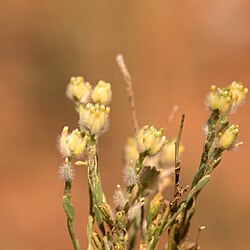Biology:Pimelea trichostachya
| Annual rice-flower | |
|---|---|

| |
| Flowers of Pimelea trichostachya near Bourke, New South Wales | |
| Scientific classification | |
| Kingdom: | Plantae |
| Clade: | Tracheophytes |
| Clade: | Angiosperms |
| Clade: | Eudicots |
| Clade: | Rosids |
| Order: | Malvales |
| Family: | Thymelaeaceae |
| Genus: | Pimelea |
| Species: | P. trichostachya
|
| Binomial name | |
| Pimelea trichostachya Lindl.[1]
| |
Pimelea trichostachya, commonly known as annual riceflower, spiked riceflower[2] or flax weed,[3] is a species of flowering plant in the family Thymelaeaceae and is endemic to continental Australia. It is a slender, semi-woody, annual shrub with narrowly elliptic or linear leaves and densely hairy, white or yellow flowers and green, purple-tinged fruit. It is toxic to livestock.
Description
Pimelea trichostachya is a slender, erect, sem-woody annual shrub that typically grows to a height of up to 75 cm (30 in) and has hairy stems. The leaves are arranged alternately and are narrowly elliptic or linear, 4–19 mm (0.16–0.75 in) long and 0.5–5 mm (0.020–0.197 in) wide. The leaves are glabrous or sparsely hairy. The flowers are arranged in head-like spikes about 10 mm (0.39 in) long and wide, on the ends of branchlets on a peduncle up to 19 mm (0.75 in) long, each flower on a hairy pedicel. The flowers are bisexual, white or yellow and densely covered with long, spreading hairs. Flowering occurs in most months with a peak from August to December and the fruit is green with a purplish tinge and about 3 mm (0.12 in) long.[2][4][5][6][7][8]
Taxonomy
Pimelea trichostachya was first formally described in 1848 by John Lindley in Thomas Mitchell's Journal of an Expedition into the Interior of Tropical Australia.[9][10] The specific epithet (trichostachya) means "hairy flower-spike".[11]
Distribution
Annual rice-flower mainly grows in deep sand im mallee and occurs in all mainland states and the Northern Territory, but is absent from most of the north of the country, from the east and west coasts and from most of Victoria.[2][4][5][6][7][8]
Effect on livestock
Pimelea trichostachya, along with P. simplex and P. elongata, is toxic to stock. The first cases of "St George disease" were reported in Queensland in 1921, but it was not until 1960 that pimelea poisoning was identified as the cause. Symptoms of poisoning in cattle include fluid swellings, mostly under the jaw, diarrhoea and weight loss. Horses and sheep are also susceptible.[3][12]
References
- ↑ "Pimelea trichostachya". https://biodiversity.org.au/nsl/services/apc-format/display/70883.
- ↑ 2.0 2.1 2.2 "Pimelea trichostachya". Northern Territory Government. http://eflora.nt.gov.au/factsheet?id=5763.
- ↑ 3.0 3.1 "Understanding Pimelea Poisoning of Cattle". Queensland Department of Agriculture and Fisheries. https://www.daf.qld.gov.au/__data/assets/pdf_file/0004/74272/Understanding-pimelea-poisoning-of-cattle.pdf.
- ↑ 4.0 4.1 "Pimelea trichostachya". Royal Botanic Gardens Victoria. https://vicflora.rbg.vic.gov.au/flora/taxon/ec4b4fea-d2e1-4f27-9265-9beefbdd3f68.
- ↑ 5.0 5.1 "Pimelea trichostachya". Australian Biological Resources Study, Department of Agriculture, Water and the Environment: Canberra. https://profiles.ala.org.au/opus/foa/profile/Pimelea%20trichostachya.
- ↑ 6.0 6.1 "Pimelae trichostachya". State Herbarium of South Australia. http://www.flora.sa.gov.au/cgi-bin/speciesfacts_display.cgi?form=speciesfacts&name=Pimelea_trichostachya.
- ↑ 7.0 7.1 "Pimelea trichostachya". FloraBase. Western Australian Government Department of Parks and Wildlife. https://florabase.dpaw.wa.gov.au/browse/profile/5271.
- ↑ 8.0 8.1 Harden, Gwen J.. "Pimelea trichostachya". Royal Botanic Garden Sydney. https://plantnet.rbgsyd.nsw.gov.au/cgi-bin/NSWfl.pl?page=nswfl&lvl=sp&name=Pimelea~trichostachya.
- ↑ "Pimelea trichostachya". https://biodiversity.org.au/nsl/services/rest/instance/apni/25170. Retrieved 20 October 2022.
- ↑ Mitchell, Thomas Livingstone (1848). Journal of an Expedition into the Interior of Tropical Australia. Sydney. p. 355. http://www.gutenberg.org/files/9943/9943-h/9943-h.htm. Retrieved 20 October 2022.
- ↑ Sharr, Francis Aubi; George, Alex (2019). Western Australian Plant Names and Their Meanings (3rd ed.). Kardinya, WA: Four Gables Press. p. 326. ISBN 9780958034180.
- ↑ Marshall, Alys. "Queensland cattle graziers predict 'horrific' cattle deaths as toxic pimelea booms". ABC News. https://www.abc.net.au/news/rural/2022-10-20/cattle-graziers-expect-horrific-pimelea-toxicity-deaths/101547534.
Wikidata ☰ Q17582265 entry
 |


